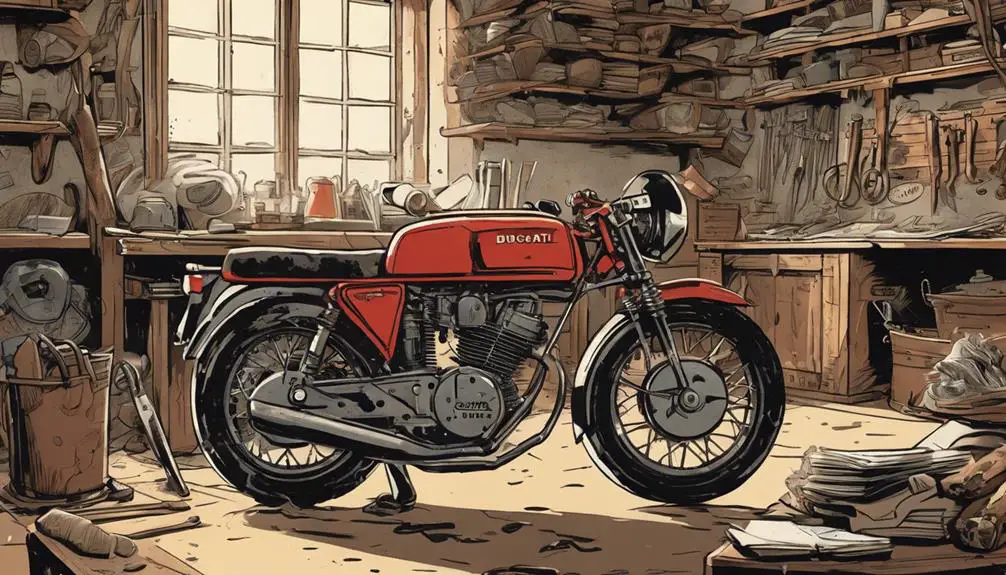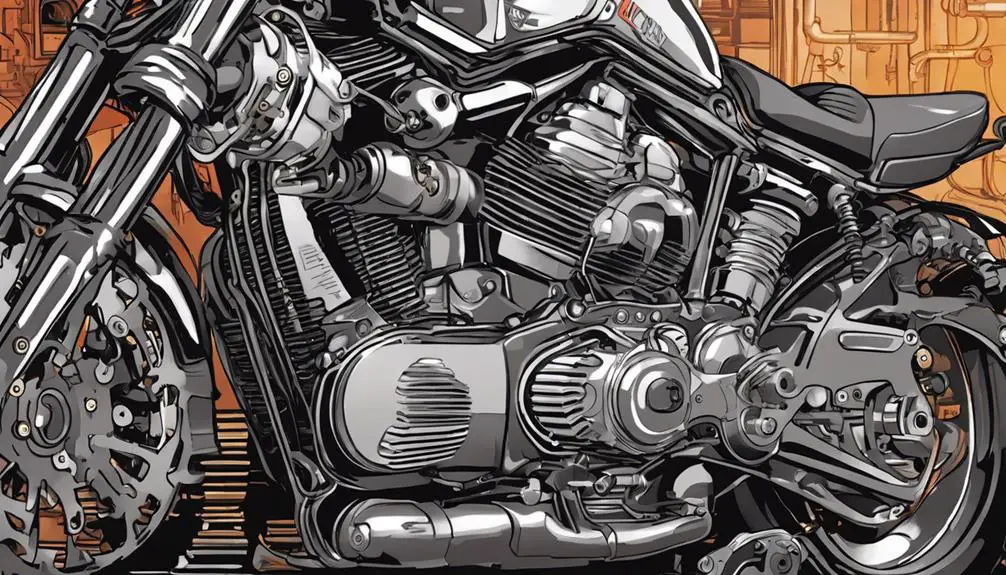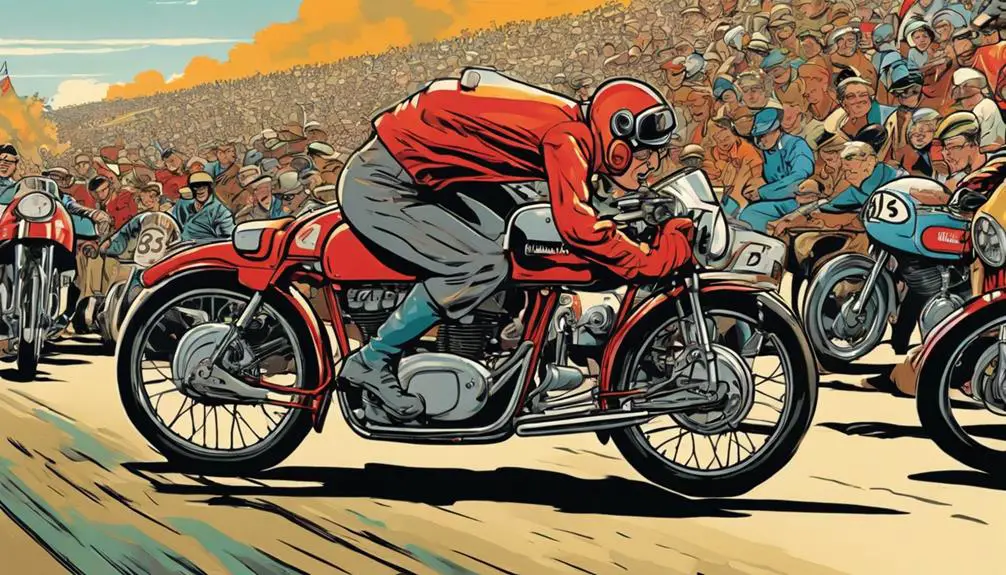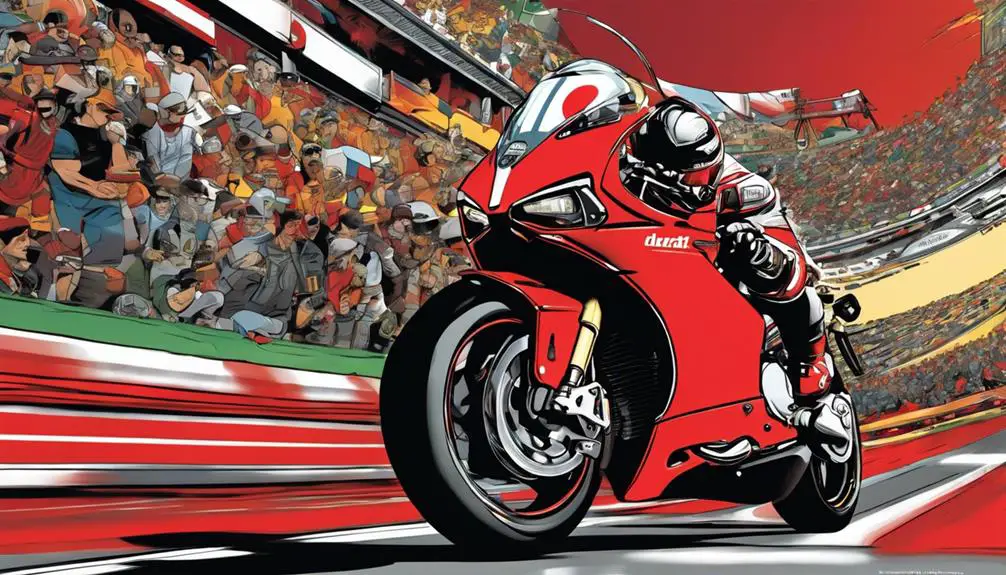You might not know that Ducati started out in 1926 as a manufacturer of radio components before making the pivotal shift to motorcycles after World War II. This transformation marked the beginning of a remarkable journey that would see the brand become synonymous with high-performance and innovative engineering. From lightweight bikes that dominated racing to groundbreaking models that changed the motorcycle landscape, Ducati's history is rich and complex. What led to these significant shifts, and how did Ducati carve out its niche in the competitive world of motorcycles?
Key Takeaways
- Ducati was founded in 1926 in Bologna, Italy, initially focusing on radio components before shifting to motorcycle production post-World War II.
- The first notable motorcycle models, the Ducati 98 and 125, were introduced in 1946 and 1950, respectively, establishing Ducati's reputation for performance.
- Ducati gained recognition in motorcycle racing during the 1950s, showcasing its innovative designs and engineering excellence.
- The introduction of the Desmodromic valve system and lightweight materials in the 1990s marked significant technological advancements in Ducati motorcycles.
Early Beginnings of Ducati

Ducati's journey began in 1926 when three brothers, Adriano, Marcello, and Bruno Cavalieri Ducati, established the company in Bologna, Italy, initially focusing on radio components. This was a time of innovation and change, where the brothers sought to break free from conventional manufacturing. They dreamed of creating something that would ignite passion and freedom.
As they navigated through the challenges of the early 20th century, they embraced a spirit of experimentation. They explored engineering, pushing the boundaries of what was possible. The brothers weren't just building products; they were laying the groundwork for a legacy rooted in performance and design. Each radio component was a step toward a greater vision, a quest for liberation through technology and creativity.
You can feel the excitement of their ambitions, as they transformed their humble beginnings into a brand that would one day stand for more than just machines. Their commitment to quality and innovation paved the way for a future where the roar of a Ducati would symbolize freedom on two wheels. This was just the beginning of a remarkable journey that would resonate with enthusiasts worldwide.
The First Ducati Motorcycles
When you think about the first Ducati motorcycles, you can't ignore the company's early manufacturing beginnings that set the stage for innovation.
The initial production models not only showcased Ducati's craftsmanship but also hinted at the racing heritage that would define the brand.
Let's explore how these elements came together to shape Ducati's iconic status in the motorcycle world.
Early Manufacturing Beginnings
In 1926, a small company in Bologna, Italy, began crafting its first motorcycles, setting the stage for what would become a legendary brand in the world of motorcycling. You can feel the passion and innovation that fueled those early days. Ducati started with modest beginnings, aiming to create machines that not only provided transportation but also represented freedom and adventure.
The team, driven by their love for engineering, focused on creating lightweight, efficient motorcycles that appealed to riders seeking liberation from the ordinary. They experimented with various designs and technologies, determined to carve out a unique identity in the burgeoning motorcycle market. As you immerse yourself in this rich history, you'll notice how Ducati's commitment to quality and performance emerged early on.
These first motorcycles weren't just vehicles; they were a declaration of independence for riders craving excitement and individuality. The groundwork laid during these formative years would inspire generations of motorcyclists to embrace the open road, and ultimately, the spirit of Ducati. You can almost hear the roar of those early engines, echoing the promise of freedom that still defines the brand today.
First Production Models
The early passion for innovation led to the development of Ducati's first production models, showcasing the brand's commitment to performance and style from the outset. In 1946, Ducati introduced the Ducati 98, a lightweight bike that embodied freedom on two wheels. With a 98cc engine, it offered an exhilarating ride while maintaining simplicity—perfect for those craving adventure.
Following the 98, the Ducati 125 emerged in 1950, capturing the spirit of liberation even further. This model featured a more powerful engine and an updated design that appealed to riders looking for speed and elegance. As you hopped on these machines, you felt an undeniable connection to the open road, igniting a passion for exploration.
Ducati's early models weren't just motorcycles; they were a call to break free from the ordinary. Each bike represented a blend of engineering excellence and Italian flair, enticing riders to embrace the thrill of the ride. You weren't just riding; you were part of a movement that celebrated individuality and the pursuit of freedom.
These first production models laid the groundwork for Ducati's legendary status in the motorcycle world, inviting countless enthusiasts to join the journey.
Racing Heritage Influence
Ducati's racing heritage profoundly shaped its earliest motorcycles, infusing them with a spirit of competition and performance that still resonates today. You can feel that legacy in every twist of the throttle, every curve of the frame. The early models, like the 125 Montjuïc, were built not just for the road but for the racetrack, embodying the passion and drive that fuels Ducati's existence.
As you ride, you're not just experiencing a motorcycle; you're connecting with a history steeped in victories and triumphs. Ducati's commitment to performance isn't merely a marketing strategy—it's the essence of the brand. The engineering innovations born from racing challenges have made their way into production bikes, ensuring that you get a taste of that adrenaline rush with every ride.
Whether you're tearing down a straightaway or carving through corners, you're partaking in a lineage that celebrates speed, agility, and freedom. Ducati's early racers laid the groundwork for what you experience today, marrying style with substance.
Innovations in Engine Technology

Throughout its history, Ducati has pioneered several groundbreaking innovations in engine technology that have greatly enhanced motorcycle performance and efficiency.
One of the key advancements is the introduction of the Desmodromic valve system. This unique design allows precise control of valve timing, boosting power and throttle response while reducing mechanical wear. It's a game-changer for those who crave the thrill of the ride.
Ducati's engineers have also made strides in lightweight materials, such as using forged aluminum and composites in engine construction. This reduces overall weight without sacrificing strength, empowering you to experience agility like never before.
Additionally, the incorporation of advanced electronics, such as ride-by-wire throttle and traction control, gives you greater command over your bike, allowing you to push boundaries safely.
The L-twin engine configuration, with its unique character and distinctive sound, adds to the exhilarating experience of riding a Ducati.
These innovations not only enhance performance but also resonate with your desire for freedom on the open road. With each technological leap, Ducati solidifies its position as a leader, ensuring that every ride feels liberating and exhilarating.
Impact of World War II
World War II forced Ducati to shift its production focus to motorcycles, responding to the urgent demand for efficient transportation.
This period sparked innovations in design, as the company adapted to new technologies and materials.
After the war, Ducati capitalized on these advancements, leading to significant market expansion.
Production Shift to Motorcycles
The onset of World War II forced many manufacturers, including Ducati, to pivot from producing radios and other electronics to focus on motorcycle production to meet the demands of a changing economy. As the war intensified, the need for reliable and efficient transportation became essential. Motorcycles emerged as a practical solution, enabling military personnel and civilians alike to navigate through challenging terrains.
Ducati embraced this shift, leveraging its existing expertise in engineering and production. You'll find that their commitment to quality and performance became evident in every model they released. The move to motorcycles not only sustained the company during the war but also laid the groundwork for its post-war success.
This period marked a significant turning point, where Ducati transformed from a manufacturer of consumer electronics to a prominent player in the motorcycle industry. You can appreciate how this adaptation was vital, reflecting the resilience and ingenuity of the brand. By focusing on motorcycles, Ducati not only responded to immediate demands but also planted the seeds for future innovations and a legacy that continues to inspire riders seeking freedom on two wheels.
Innovations in Design
Amid the challenges of World War II, Ducati seized the opportunity to innovate in motorcycle design, incorporating advanced engineering techniques that would define its future models. During this tumultuous time, the company focused on creating lightweight, efficient motorcycles. Engineers experimented with new materials, such as aluminum, which allowed for reduced weight without sacrificing strength.
These innovations weren't just about performance; they were about liberation. As the war forced many to seek freedom from oppression, Ducati's designs symbolized a new era of mobility and independence. The introduction of the Cucciolo engine, a small yet powerful unit, reflected this spirit.
The Cucciolo showcased Ducati's commitment to practicality, turning motorcycles into accessible means of transport for everyday people. By prioritizing simplicity and usability, Ducati made motorcycles not merely machines but instruments of liberation.
This period marked a pivotal shift, where creativity flourished amidst adversity. These design innovations laid the groundwork for Ducati's enduring legacy, crafting motorcycles that resonate with the desire for freedom and adventure. Each model that followed would carry the essence of that wartime innovation, propelling riders toward new horizons.
Post-War Market Expansion
After the war, Ducati capitalized on its innovative design successes to expand into new markets, meeting the rising demand for affordable and efficient transportation. You'll find that this period marked a significant shift in the motorcycle industry. With Europe in recovery mode, people craved freedom and mobility, and Ducati was ready to deliver.
The introduction of models like the Ducati 125 and 175 not only showcased cutting-edge engineering but also appealed to a broader audience seeking liberation from post-war constraints. These bikes were lightweight, easy to handle, and offered impressive fuel efficiency, allowing you to explore the open roads without breaking the bank.
Ducati's commitment to quality and performance caught on quickly, making it a household name. The company's strategic partnerships and investments in marketing further propelled its growth. You could sense the excitement in the air as more riders embraced the spirit of adventure that Ducati embodied.
The 1950s Racing Success

Ducati's emergence in the 1950s marked a thrilling chapter in motorcycle racing, as the brand quickly gained recognition for its innovative designs and competitive spirit. You can almost feel the excitement in the air as Ducati motorcycles tore through the tracks, leaving competitors in the dust. This era was defined by remarkable performances and iconic models that captured the hearts of fans and riders alike.
Picture the adrenaline-fueled moments as Ducati achieved racing milestones with:
- The sleek, powerful 125cc Desmo, a true marvel of engineering.
- Riders pushing the limits, their passion igniting the track.
- The roar of engines, echoing through the hills, calling to the free spirit in you.
In this decade, the brand embraced the essence of liberation, allowing riders to feel the wind in their hair and the freedom of the open road. The 1950s solidified Ducati's place in racing history, igniting a legacy that continues to inspire riders today.
Expansion Into Global Markets
How did Ducati transform from a local Italian brand into a global powerhouse in the motorcycle industry? By daring to innovate and embrace the spirit of adventure, Ducati expanded its reach beyond Italy.
You'll see that in the late 20th century, they began crafting motorcycles that not only appealed to local riders but also captured the hearts of enthusiasts worldwide.
With strategic marketing and a focus on performance, Ducati positioned itself as a symbol of freedom and exhilaration. They embraced the culture of motorcycling, sponsoring events and fostering a community that celebrates the thrill of the ride.
You're not just buying a bike; you're joining a movement that values speed, style, and passion.
Ducati also tapped into emerging markets, recognizing the growing appetite for high-performance motorcycles in countries like the United States and Asia. They built partnerships and dealerships that made their iconic machines accessible to a broader audience.
This expansion wasn't just about sales; it was about sharing a lifestyle that empowers riders to break free from the ordinary. Ducati isn't merely a brand; it's an invitation to release your spirit and conquer the open road.
Iconic Models Through the Decades
Throughout the decades, Ducati has produced a range of iconic models that have defined the motorcycle landscape and captured the imagination of riders everywhere. Each bike tells a story, inviting you to experience freedom on two wheels. From the roar of the engine to the sleek design, these machines embody the spirit of adventure.
Imagine riding one of these legendary models:
- Ducati 750 Sport: The bike that set the standard for performance in the 1970s, with a classic café racer look.
- Ducati 916: An embodiment of beauty and power, this masterpiece in the 1990s changed the game with its innovative design and superb handling.
- Ducati Monster: Launched in the 1990s, this naked bike became a symbol of urban freedom, perfect for those who crave agility.
Each model invites you to break free from the mundane and embrace the exhilarating world of Ducati motorcycles.
Technological Advancements in the 1990s
In the 1990s, Ducati made significant strides in motorcycle technology that transformed performance on the road.
You'll notice the introduction of the Desmodromic Valve System, which enhanced engine efficiency and power delivery.
Additionally, lightweight frame innovations helped improve handling, giving riders a more exhilarating experience.
Desmodromic Valve System
Ducati revolutionized motorcycle performance in the 1990s with its innovative Desmodromic Valve System, which guaranteed precise control over valve operation. This technology set Ducati apart, allowing you to experience the thrill of riding in ways you never thought possible.
With the Desmodromic system, you're not just riding; you're releasing the full potential of your machine. Imagine the exhilaration as you feel the power of your bike responding flawlessly to your every command.
Picture:
- Increased RPMs: Push your limits as the engine revs higher with confidence.
- Enhanced Acceleration: Experience a surge of speed that propels you forward.
- Improved Handling: Tackle curves and straightaways with a newfound precision.
This system not only promotes performance but also embodies the spirit of liberation that comes with Ducati. You're not just another rider; you're part of a legacy that embraces innovation and freedom.
With the Desmodromic Valve System, you're in command, feeling the wind on your face and the roar of the engine beneath you. It's time to embrace the ride.
Lightweight Frame Innovations
During the 1990s, Ducati considerably enhanced motorcycle performance with lightweight frame innovations that improved agility and handling for riders like you. The introduction of trellis frames changed the game, utilizing tubular steel to create a rigid yet lightweight structure. This design not only reduced weight but also offered superior strength, allowing you to experience sharp cornering and responsive maneuverability.
As you ride, you can feel the difference. The reduced mass translates to a more flickable bike, giving you the freedom to navigate tight turns and twisty roads with ease. Innovations like the use of aluminum and composite materials further decreased weight, enhancing speed without compromising durability.
Ducati's commitment to performance meant that every component was meticulously designed to maximize your riding experience. The result? A new generation of motorcycles that felt alive beneath you, empowering your passion for the open road.
Whether you're carving through canyons or cruising down highways, these lightweight frames bring a sense of liberation, allowing you to fully embrace the thrill of riding. Ducati's innovations during this era set the stage for a legacy of performance that's still felt in their bikes today.
Recent Developments and Collaborations

Recent collaborations have propelled Ducati into the forefront of innovation, enhancing its reputation for cutting-edge technology and design. By partnering with industry leaders and visionaries, Ducati's expanding horizons have sparked excitement among riders like you, who crave freedom and performance.
Imagine the thrill as you experience:
- Next-gen electronics that fine-tune your ride in real-time, ensuring every twist and turn is met with precision.
- Sleek, aerodynamic designs that not only look stunning but also slice through the wind, giving you that rush of liberation on open roads.
- Sustainable materials that push boundaries, allowing you to ride with a conscience while still enjoying the raw power of a Ducati.
These developments aren't just about aesthetics; they embody a commitment to pushing the limits of what you can achieve on two wheels.
With Ducati, you're not just riding a motorcycle; you're part of a movement that embraces innovation, freedom, and the sheer joy of the open road.
Ducati's Legacy and Future
Building on a rich heritage of performance and innovation, Ducati's legacy continues to shape the future of motorcycling, inviting you to be part of its exhilarating journey. As you twist the throttle on a Ducati, you're not just riding a motorcycle; you're embracing a philosophy of freedom, speed, and engineering excellence. Each model reflects a commitment to pushing boundaries, whether you're carving through twisty roads or cruising on the open highway.
Ducati's future shines brightly with advancements in technology and a focus on sustainability. You'll see cutting-edge electric models and hybrid systems designed to enhance your riding experience while respecting the environment. The brand's commitment to racing feeds directly into its street models, ensuring that you benefit from innovative designs and performance enhancements.
Moreover, Ducati's vibrant community of riders fosters a sense of belonging and adventure. Joining this legacy means connecting with fellow enthusiasts who share your passion for liberation and the thrill of the ride. As Ducati evolves, you'll find that each twist and turn of the road is an invitation to explore and redefine your limits—making every journey a new chapter in your own story.
Frequently Asked Questions
What Is the Meaning Behind the Ducati Logo?
The Ducati logo features a bold, red shield with a white wordmark, symbolizing speed, passion, and Italian craftsmanship.
When you see it, you're reminded of the adrenaline and freedom that comes with riding a Ducati motorcycle.
The shield shape evokes a sense of strength and protection, while the vibrant colors ignite excitement.
It's not just a logo; it embodies a lifestyle centered around performance, innovation, and the thrill of the open road.
How Has Ducati Influenced Motorcycle Culture?
Ducati's influence on motorcycle culture is undeniable.
You see, their sleek designs and powerful performance inspire a sense of freedom and adventure.
Riders gravitate towards the brand as it symbolizes rebellion and passion.
The iconic sound of a Ducati engine revving sparks excitement, pushing you to embrace the open road.
Plus, their commitment to innovation encourages you to push boundaries and explore new possibilities, making Ducati a true revolution in motorcycling.
What Are the Most Popular Ducati Motorcycle Models Today?
If you're searching for standout Ducati models today, the Scrambler series shines brightly, blending style and substance.
The Panigale lineup promises pulse-pounding performance and precision.
You can't overlook the Multistrada, which masters versatility, perfect for both touring and thrilling rides.
Each model captures the essence of freedom, inviting you to embrace the open road.
Who Are Some Famous Ducati Motorcycle Riders?
When you think of famous Ducati motorcycle riders, names like Troy Bayliss and Casey Stoner probably come to mind. These champions have dominated the racetrack, showcasing Ducati's power and precision.
You might also recognize riders like Andrea Dovizioso and Valentino Rossi, who've pushed the limits on Ducati machines. Their passion and skill inspire you to embrace the freedom that comes with riding, making every twist and turn an exhilarating experience.
What Events Celebrate Ducati Motorcycles Globally?
You'll find several events celebrating Ducati motorcycles globally, like the Ducati World Week in Italy, where fans gather for races, rides, and exhibitions.
There's also the MotoGP, showcasing Ducati's performance on a grand stage, thrilling enthusiasts.
Local bike rallies and custom shows often feature Ducati categories, letting you connect with fellow riders.
Don't miss the chance to experience these vibrant gatherings, where passion for Ducati burns bright among riders and fans alike!
Conclusion
Ducati's journey from post-war Italy to becoming a motorcycle legend is nothing short of remarkable.
You've witnessed how innovation and passion fueled its rise, creating iconic models that still turn heads today.
As you rev up your own bike, remember the spirit of Ducati—a blend of power, style, and engineering excellence.
With a legacy that continues to inspire, Ducati's future is as thrilling as a ride down the open road in a self-driving car.